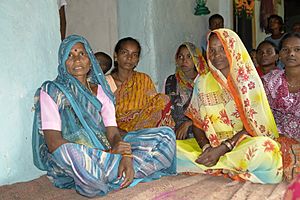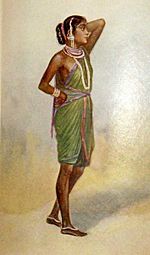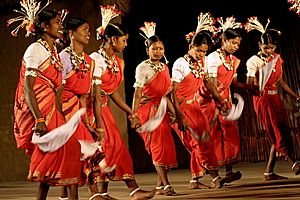Gondi people facts for kids
| Koitur | |
|---|---|

Gondi women in Umaria district, India
|
|
| Total population | |
| c. 13 million | |
| Regions with significant populations | |
| India | |
| Madhya Pradesh | 5,093,124 |
| Chhattisgarh | 4,298,404 |
| Maharashtra | 1,618,090 |
| Odisha | 888,581 |
| Uttar Pradesh | 569,035 |
| Andhra Pradesh and Telangana | 304,537 |
| Bihar | 256,738 |
| Karnataka | 158,243 |
| Jharkhand | 53,676 |
| West Bengal | 13,535 |
| Gujarat | 2,965 |
| Languages | |
| Gondi • Regional languages | |
| Religion | |
| Native: traditional religion (Koyapunem), Nature Worship with significant influence from Hinduism | |
| Related ethnic groups | |
| Dravidian people • Muria people • Madia Gond | |
The Gondi (also called Gond or Koitur) are a large group of people in India. They speak a language called Gondi, which is part of the Dravidian language family, like Telugu. The Gondi people live in many states across central India, including Madhya Pradesh, Maharashtra, Chhattisgarh, Uttar Pradesh, Telangana, Andhra Pradesh, Bihar, and Odisha.
The Indian government lists the Gondi as a Scheduled Tribe. This means they are a recognized group with special protections and support. Historically, the Gondi people created many important kingdoms.
In 2011, about 2.98 million people spoke Gondi. However, many Gondi people also speak other languages like Hindi, Marathi, Odia, and Telugu. The number of Gondi speakers has decreased over time.
Contents
What's in a Name?
The name 'Gond' was given to this group by outsiders. Its exact origin is not fully known. Some people think it comes from the word konda, which means 'hill'. This is similar to another group called the Khonds of Odisha.
The Gondi people call themselves Koitur. Some experts believe this name is connected to the Khond's own name for themselves, Kui.
A Look at History
The exact beginnings of the Gondi people are still debated. Some believe they were different tribes who started speaking a common language from their rulers. Genetic studies show they are different from the Munda people, but they have shared many genes over time.
Experts believe that the Gondi people ruled a large area called Gondwana from the 13th to the 19th centuries. This region stretched across parts of what is now Madhya Pradesh, Odisha, Andhra Pradesh, and Uttar Pradesh.
One of the first Gondi kingdoms was Chanda, founded around 1200 CE. The rulers of Chanda were known for building strong forts and creating a good system for collecting taxes. They even expanded their territory.
Another famous kingdom was Garha. It is well-known because of its brave queen, Rani Durgavati. She was a warrior who fought against the powerful Mughal emperor Akbar until she died in battle in 1564. Her son, Bir Narayan, also fought bravely.
The kingdom of Deogarh was founded in the early 13th century. One of its important rulers was Bakht Buland Shah. He founded the city of Nagpur and helped the Deogarh kingdom become strong.
These Gondi kingdoms were sometimes taken over by the Mughals, but often the Gondi kings were allowed to rule again under Mughal influence. Later, in the 1740s, the Marathas started attacking the Gondi kingdoms. This caused many Gondi people to move from the plains into the forests and hills for safety.
When the British took control, they changed how they saw the Gondi people. At first, they thought of them as "plunderers," but later they saw them as "timid." After India became independent, the remaining Gondi territories joined the Indian Union.
Fighting for Rights
During British rule, the Gondi people faced challenges because of new forest rules. These rules made it hard for them to use the forests for their daily lives. In 1910, the Bastar rebellion (also known as bhumkal) was a partly successful fight against these rules.
In the 1920s, a Gondi leader named Komaram Bheem from Adilabad fought against the local ruler. He wanted a separate Gondi kingdom. He created the famous slogan jal, jangal, jameen, which means "water, forest, land." This slogan has become a symbol for many tribal movements in India.
In 1916, Gondi thinkers formed the Gond Mahasabha. This group aimed to protect Gondi culture from outside influences. They held meetings to discuss how to preserve their traditions and unite Gondi people from different areas.
Starting in the 1940s, some Gondi leaders began asking for a separate state called Gondwana. They wanted this state to include the tribal areas where Gondi people lived. This demand was strongest in the 1950s, but it was never taken seriously by the government. Today, the Gondwana Ganatantra Party continues to fight for statehood.
Raj Gonds
In the past, there were three types of Gonds: the Sur Gonds, the Nand Gonds, and the Raj Gonds. The Raj Gonds were considered the most important. They were often educated, owned land, and were wealthier. They sometimes used titles like Singh or Shah, influenced by the Rajputs and Mughals. The term Raj Gond was common in the 1950s but is less used now.
Society and Family
Gondi society is organized into groups called sagas. These are like large family units that trace their origins back to common ancestors. The number of ancestors for each saga is important and is often used in ceremonies.
These sagas are important for rituals and marriage rules. People from the same saga are considered related and cannot marry each other. They can only marry people from other sagas, which they call soira.
Each saga has a special role in society. For example, during ceremonies, members of different sagas might have different jobs, like preparing food or dressing idols. All sagas are seen as equal in Gondi society.
Clans and Lineages
Inside each saga are smaller groups called pari, or clans. The clans are the main way Gondi society is organized. The clans are arranged by how they appeared in the Gondi creation story, with older clans having more importance in some rituals. For example, members of an older clan cannot marry a widow from a younger clan.
Clans often have names related to plants. Some common clan names include Tekam, Uikey, Markam, Dhurwe, and Atram.
Clans are also divided into kita, or lineages. Each kita has specific roles in religious ceremonies. For example, only the katora kita can lead the worship of Persa Pen, a great god. Sometimes, clans are also divided into khandan, or subclans, which are like mini-clans with their own ritual objects.
Culture and Traditions
The ancient Gondi people had a good understanding of astronomy. They had their own names for the Sun, Moon, Milky Way, and different groups of stars. They used this knowledge to keep track of time and create their calendars.
The Gondi language is spoken by about 3 million Gondi people, mainly in the southern parts of their region. It is related to the Telugu language. While many Gondi people used to speak their own language, today only about one-fifth of them do. The language is slowly disappearing in some areas.
In Chhattisgarh, Gondi women perform the sua dance. This dance is named after the word for "parrot." It is performed after the Diwali festival to honor the gods Shiva and Parvati. The dance shows the belief that parrots will carry their sadness to their loved ones.
The Gondi people also have their own version of the famous Ramayana story, called the Gond Ramayani. It is based on their oral traditions and folk tales. It tells seven stories where Lakshmana is the main hero, searching for a bride after the main events of the Ramayana.
Beliefs and Religion
Most Gondi people still follow their traditional beliefs, which involve worshipping nature. However, their religion has also been influenced by Hinduism.
Many Gondi people practice Hinduism, while others follow their own native religion called Koyapunem.
Some Gonds also follow Sarnaism, another indigenous religion. Important festivals for the Gondi people include Pola (a cattle festival), Phag, and Dassera. A small number of Gonds are Christians or Muslims.
Koyapunem (Native Gondi Religion)
| Gondi people | |
|---|---|

Symbol of the Gondi religion, Koyapunem.
|
The traditional Gondi religion is called Koyapunem, which means "the way of nature." It is also known as Gondi Punem, or "the way of the Gondi people." This religion was founded by a hero named Pari Kupar Lingo.
In Gondi traditions, people worship a main god called Baradeo. Other names for him include Bhagavan, Kupar Lingo, Badadeo, and Persa Pen. Baradeo oversees other gods, like those of clans and villages, and also ancestors. While Baradeo is respected, people show more strong devotion to their clan and village gods, ancestors, and totems (special animals or plants).
Village gods include Aki Pen, who protects the village, and the anwal, the village mother goddess. These gods are worshipped before any festival. Each clan also has its own persa pen, meaning "great god." This god is kind but can sometimes be fierce. However, if a pardhan (a bard or storyteller) plays a fiddle, the god's fierce side calms down.
Three important people lead Gondi religious ceremonies:
- The baiga: the village priest.
- The bhumka: the clan priest.
- The kaser-gaita: the leader of the village.
Kupar Lingo, the main god of the Gonds, is often shown as a young prince with a special trident-shaped crown called the munshul. This crown represents the head, heart, and body. There are many shrines to Kupar Lingo in Gondwana, as he is seen as an important ancestor and hero.
According to Gondi beliefs, their ancestor Rupolang Pahandi Pari Kupar Lingo was born many thousands of years ago. He became the ruler of the Koya people and created the Gondi Punem, which is a set of rules and ideas for how Gondi people should live. He gathered 33 students to teach the Gondi Punem to people in distant lands.
An important idea in the Gondi religion is munjok, which means being non-violent, working together, and defending oneself. Another belief is salla and gangra, which are like action and reaction, similar to the idea of karma in Hinduism. To avoid conflict, people are supposed to live in a "Phratrial" society. This means defending the community, working together, living in harmony with nature, and being allowed to eat animals (but not animals that are their totem).
Gonds also believe that their clan and village gods can possess people. When someone is possessed, they are not responsible for their actions. Gonds also think that sickness can be caused by spirits.
Many Gonds worship Ravana, whom they see as an important teacher and ancestor. They also worship Kupar Lingo as their highest god and an ancestor before Ravana. On Dussehra, some Gondi people in Gadchiroli district carry an image of Ravana in a procession to worship him.
The Gondi people respect plants and animals, especially the Saja tree. In some places, the Saja tree is linked to death. Stones representing the souls of the dead, called hanals, are kept at the foot of a Saja tree. If there is no special shrine for the village mother goddess, the Saja tree is considered her home. The Penkara, which is the holy circle of the clan, is also found under this tree. Some Gonds believe that Baradeo lives in a Saja tree. The Mahua plant, whose flowers are used to make a special drink, is also highly respected. In many Gondi weddings, the bride and groom walk around a post made from a Mahua tree.
Gonds also believe in rain gods. An early British expert noted that during a hunting ceremony before the monsoon season, the amount of blood spilled by animals was thought to show how much rain would follow.
The gods are called pen (singular) and pennoo (plural). Other gods worshipped by the Gonds include:
- Mata Kali Kankali: the ancestral mother of the Gondi people.
- Dulha-Pen: the bridegroom god.
- Gansam: the protector of villages from tigers.
- Hardul: the god of weddings.
- Bhivsen or Bhimal: the god of strength and the earth.
- Nat Awal or Dharti Mata: the goddess of fertility.
- Bhum: the earth and mother of humanity.
- Nat Auwal: the mother goddess of the village.
- Thakur Deo: the male guardian of the village.
- Hulera-Pen: the protector of cattle.
- Maitya-Pen: the demon of whirlwinds.
- Narayan-Pen: the sun god.
- Kodapen: the horse god.
- Maswasi Pen: the hunting god.
- Kanya: the water spirits.
The Gonds also worship ancestral gods called Angadevs. There were different groups of Angadevs, and they were rescued by Pari Kupar Lingo from the Kachchargardh caves. In one story, the Angadevs were the children of the goddess Mata Kali Kankali. They were trapped in the Kachchargardh caves by the gods Shambu and Gaura. Pari Kupar Lingo, with the help of a bard named Hirasuka Patalir, freed them. Since then, the Kachchargardh caves have become a place of pilgrimage.
When someone dies, Gonds often feel anger because they believe death is caused by magic or demons. Gonds usually bury their dead. In the past, their kings sometimes cremated their dead, following other traditions. Today, cremation has become more common. People's belongings were often buried with them. Gonds believe that the dead are interested in the future of the living, so they try to keep the dead happy to ensure good fortune for the living. If someone dies an unnatural death, their ancestors invite them to become a sacred spirit. Otherwise, they might become an evil spirit.
Official Status
The Gondi people are recognized as a Scheduled Tribe in many Indian states. These include Andhra Pradesh, parts of Uttar Pradesh, Bihar, Chhattisgarh, Gujarat, Jharkhand, Madhya Pradesh, Maharashtra, Telangana, Odisha, and West Bengal.
In Uttar Pradesh, the Gondi people were once listed as a Scheduled Caste. However, by 2007, the government changed their status to Scheduled Tribes in certain districts.
Famous Gondi People
- Ramji Gond
- Komaram Bheem, a freedom fighter
- Dalpat Shah, King of Garha
- Hridayshah, King of Garha
- Chakradhar Singh, King of Raigarh State
- Bhajju Shyam, Artist
- Jangarh Singh Shyam, artist
- Venkat Shyam, Artist
- Durga Bai Vyom, Artist
- Motiravan Kangali, Indian linguist and author
- Baburao Shedmake, Indian tribal freedom fighter
- Veer Narayan Singh
- Gunda Dhur
Images for kids
See also
 In Spanish: Gond para niños
In Spanish: Gond para niños








